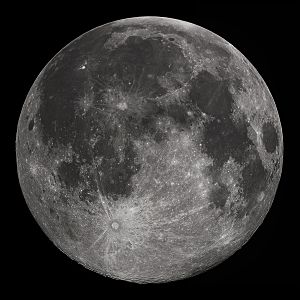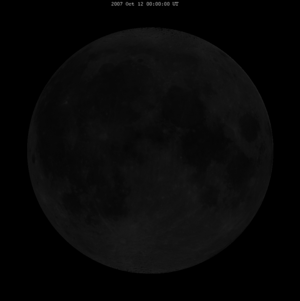Tidal locking facts for kids

Tidal locking happens when one side of a space object, like a moon, always faces another object, like a planet. It's also called synchronous rotation. The best example is our own Moon. The same side of the Moon always faces Earth.
When a body is tidally locked, it takes the same amount of time to spin around its own center as it does to go around its partner. This means one side of the object is always looking at the other. Usually, only the smaller object, like a moon, is tidally locked to a bigger planet. But if two objects are similar in size and very close, they can both be tidally locked to each other. This is true for Pluto and its moon, Charon.
If the Moon wasn't spinning at all, we would see its near side and far side taking turns as it orbits Earth.
Scientists can estimate how long it takes for tidal locking to happen. This is just a rough guess because some things are hard to know. For example, how stiff a planet or moon is, and how its shape changes from the pull of gravity. Tidal locking is part of a bigger idea called orbital resonance.
Contents
Moons and Planets That Are Tidally Locked
Many moons in our Solar System are tidally locked to their planets. This means they always show the same face to their planet.
Moons Locked to Earth
Moons Locked to Mars
Moons Locked to Jupiter
Moons Locked to Saturn
Moons Locked to Uranus
Moons Locked to Neptune
Moons Locked to Pluto
- Charon (Pluto is also locked to Charon)
Planets Outside Our Solar System
- Tau Boötis is a star that is tidally locked to its giant planet, Tau Boötis b.
What is Libration?
Libration is a small, wobbly movement of objects that orbit each other. For example, the Moon wobbles a little bit as it goes around Earth. This also happens with Trojan asteroids as they orbit planets.
Because of tidal locking, the Moon usually shows only one side to Earth. This is why we didn't see the far side of the Moon until space missions in the 1960s.
However, this isn't exactly true. Over time, we can actually see a little more than half of the Moon's surface from Earth. About 59% of the Moon becomes visible because of libration. Libration is like a slow rocking motion of the Moon. It lets us see slightly different parts of its surface at different times.
Images for kids
-
Tidal locking makes the Moon spin at almost the same speed it orbits Earth. This means the Moon keeps the same side facing Earth, as shown on the left. (The Moon is seen from above its pole and is not to scale.) If the Moon didn't spin at all, it would show its near and far sides as it moved around Earth, as shown on the right.
See also
 In Spanish: Acoplamiento de marea para niños
In Spanish: Acoplamiento de marea para niños



